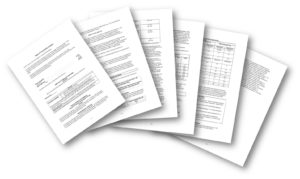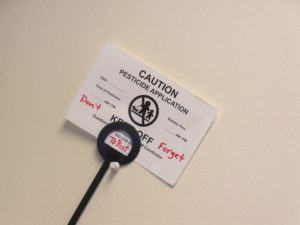How are your records? This isn’t the most exciting of topics, but this is a good time a year to take time to review your IPM program and your recordkeeping procedures.
Posting
![]() Texas Department of Agriculture (TDA) requires that prior to any indoor pest control treatment 48 hours in advance. This posting notification must be placed in an area of common access for schools, child care centers, nursing homes, hospitals, hotels, motels, food processing plants and warehouses. For those of you who service apartment complexes in 2018 you will need to provide pest control sign to a residential rental property owner or manager at least 48 hours prior to a planned indoor treatment at a residential rental property with five (5) or more rental units. This sign must be on paper that is letter size (8 1/2 inches by 11 inches) and contain the required information with the first line in a minimum of 24-point type (one-fourth inch) and all remaining lines in a minimum of 12-point type (one-eighth inch). One of the items we changed for schools was adding a word to the title. You will notice our sign mentions both treatment and service. To find the TDA approved sign you can visit their website at http://www.TexasAgriculture.gov/spcs go to the forms link. Or you can download our School IPM sign PestControlNotificationSign – Schools
Texas Department of Agriculture (TDA) requires that prior to any indoor pest control treatment 48 hours in advance. This posting notification must be placed in an area of common access for schools, child care centers, nursing homes, hospitals, hotels, motels, food processing plants and warehouses. For those of you who service apartment complexes in 2018 you will need to provide pest control sign to a residential rental property owner or manager at least 48 hours prior to a planned indoor treatment at a residential rental property with five (5) or more rental units. This sign must be on paper that is letter size (8 1/2 inches by 11 inches) and contain the required information with the first line in a minimum of 24-point type (one-fourth inch) and all remaining lines in a minimum of 12-point type (one-eighth inch). One of the items we changed for schools was adding a word to the title. You will notice our sign mentions both treatment and service. To find the TDA approved sign you can visit their website at http://www.TexasAgriculture.gov/spcs go to the forms link. Or you can download our School IPM sign PestControlNotificationSign – Schools
While many schools have a contract with a pest management company for school kitchens typically making a pest control treatment at every visit isn’t always needed. However, if when the service technician is checking their monitors and does notice insect activity on the monitoring device they will have the ability to treat if this sign has been posted correctly. During our school IPM training we instruct our coordinators that these signs need to be placed in common areas that the contract covers (school cafeteria, teacher lounges, utility rooms, etc.) if the contract covers the entire district then you might want to post these signs next to doors or another area that staff and teachers can see.
Outdoors posting is required at the time of treatment and this is only for public schools. The sign must be placed on a fence that locks if the area you are treating is fenced. If the area is not fenced, like most middle school turf areas, then signs should be placed on all 4 sides of the field area. You can also use caution barrier tape or an individual to occasionally monitor to ensure that students don’t walk on the treated area. For Yellow Category products (herbicides, some fire ant products, pyrethroids) students must be kept off the treated surface for four hours. For Red category products (warning or danger signals word) students must be kept off the treated surface for 8 hours.
Justification Forms
Justification forms or most will know this as Yellow and Red Category approval is still one of the top non-compliance violations for school districts. In most cases this is due to the IPM Coordinator and Certified Applicator not realizing what is considered Yellow Category. The other reason for not getting this document is that some school districts contract out their athletic field maintenance and in some cases those contractors do not realize that they MUST give the IPM Coordinator a copy of their application use records and a justification form. To make this easy for you if your certified applicator is using an herbicide and it has a Caution Signal word – the product is Yellow and requires a justification form. While the justification form is good for 6 months or 6 applications per site listed, I recommend that a form be completed by the applicator and placed with the application use record. By putting these two documents together will make it easier when your district is inspected by TDA. If your applicator is using residual products with pyrethroids or other synthetic products (Talstar, Tempo, Amdro, Advion Fire Ant Bait, to name a few) then they will also need to complete a justification form. This is especially important if they are making an indoor treatment, you want to make sure you have the correct paperwork in the event you receive an inquires from teachers, staff members, or parents.
Here is the correct form to use Justification form
Remember we have our Recognizing Green Category Products for Schools
Application Use Records/Service tickets
Completing the service ticket is one of the most important things we do in pest control, but I’m always amazed when I find these documents missing information. What did you use? Typically, I will see part of the products trade name but it’s not the full name, it’s been abbreviated which is fine when you are making notes to yourself, but on the service ticket it all needs be there. Add the EPA registration number and then anyone can see the exact product you used and can look it up if necessary. For mixed solutions TDA requires you to complete the mixing rate question typically this solution rate is found in the pesticide label. And this number is different than how much you applied. Per TDA rules “the mixing rate and total amount of material applied or the percentage of active ingredient(s) and total amount of material applied for manufacturer’s formulations that are mixed with water or other material, if applicable” is what they want you to complete. At the same time, if you use any type of pest control device (snap traps, glue boards/monitoring cards, rodent bait stations, etc.) you must list how many devices used and what they are. In some cases, you might need to plot this information out on a diagram – remember when you are monitoring and controlling pests everything you do counts towards this, so document it, you never know when you will need to consult that information.
Labels and Safety Data Sheets
All pesticides used by Pest Management Professionals must be registered with the United States Environmental Protection Agency (EPA) and the Texas Department of Agriculture, except for those pesticides that have been exempted from registration by the Federal Insecticide, Fungicide, and Rodenticide Act (FIFRA), Section 25(b). All pesticides used must also bear a label as required by FIFRA and Chapter 76 of the Texas Agriculture Code. Pesticides intended and labeled for use on humans are exempt from this section, this typically covers products like head lice shampoo and insect repellant.

SDS documents are important to have on site in the event of an accident or if someone complains of side effects.
For schools they must have a copy of the pesticide label and safety data sheet (SDS) that is current and should be kept in a separate notebook or file folder. Pesticide labels contain detailed information on how to use the product correctly and legally. Labels also contain information on potential hazards associated with the product and instructions you should follow in the event of a poisoning or spill. The SDS (formerly known as MSDS) includes information such as the properties of each chemical; the physical, health, and environmental health hazards; protective measures; and safety precautions for handling, storing, and transporting the chemical. These documents are important to both the pesticide applicator and the consumer, and must be made available to anyone who requests a copy.
A good tip to remember when you are out in the field and you want to rush through your paperwork, think about this “will what I write stand up in court of law?” If someone was to file a complaint can you justify your work through your pest control records, because if you can’t now is the time to correct your information and make sure all your records are in good order.
Written by: Janet Hurley


 .
.